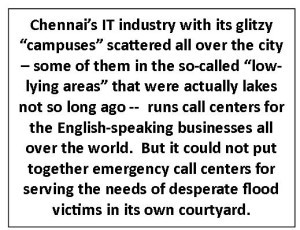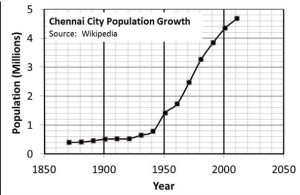By Kollengode S Venkataraman (December 2015)
Chennai, the fourth metropolis of India with a population of nearly 5 million people in the city and over 8.5 million in the expanded metro area, was inundated with incessant rains during November starting from Deepavali. This is the normal northeast monsoon season for the east coast of Southern India. Chennai received over 140 cm of rains (2.5 cm = 1 inch) during a 2-week period. This was unusually high against the normal annual rainfall of 45 cm. Such high rainfall happened nearly one hundred years ago, and was probably spread over a much longer duration. But Chennai city’s population was only 0.5 million then, with much less population density, because high-rise buildings were unknown. See the plot.
Climate change on account of human recklessness on a global scale is one contributing factor for this excess rainfall. But other local contributing factors, centered on Chennai’s reckless urbanization and growth, made the natural event into an urban disaster. Every other urban areas in India — New Delhi, Mumbai, Kolkata, Bangaluru, Hyderabad, Kochi-Ernakulam and other emerging cities — has similar foot prints in reckless urbanization. In the future, urban planners in India will use — or at least should use — the Chennai Floods of 2015 as a bad example on what not to do in urban development.
In the Tamil medium high school social studies class we were taught that the geographical area around Chennai, in the absence of any river basin, has a unique irrigation system for farming. This system, called Aerip-Paasanam in Tamil, has been in vogue for over a millennium, as the historical records show. Aerip-Paasanam, literally means Lake Irrigation. The whole region is relatively flat without any large river system like the Kaveri, Krishna, and Godavari delta in Southern India. The local rulers and land owners over the last 1000 years dug large tanks and built lakes, and de-silted them periodically, to collect the rain water during the 2 to 3 month monsoon season. They used the water thus pooled for irrigation for raising at least two crops annually. Old maps of the area show the area dotted with hundreds and hundreds and hundreds of water bodies, big and small.
Even in Chennai City, many places, before they were renamed as fancy Nagars (Anna Nagar, Kalaignar Nagar, Indira Nagar…), had the word Aeri (lake) attached to them, as in Velacheri, Otteri, Nungambakkam Aeri, Mambalam Aeri. These densely populated places, now innocuously called “low-lying areas,†were once actual lakes.
In the last 40 to 50 years, India has seen huge migration of rural population on a national scale to urban centers all across the landscape. Both the educated and the poor from every region have moved in millions into every other region on a scale unheard of to get better jobs, or simply to eke out a living.
Obviously there are great pressures on every resource in urban India, such as housing, drinking water, sewage, transportation, schools, shops for all kinds of goods and services… India’s expanding middle class has increasing access to many resources that come with education, wealth and money. However, India’s middle class and the affluent do not want to pay taxes, but expect all kinds of services from governments (ref:www.tinyurl.com/G20-IndiaTaxBase).
In Chennai’s case, the unenlightened self-interests of the segments listed below got aligned with disastrous consequences in the 2015 Floods: populist and corrupt state and local elected governments; vote-bank politics; ever increasing middle class needs for goods and services; people’s unwillingness to pay for it in taxes; land, real estate, and construction mafia; an acquiescing bureaucracy and criminal justice system; and the simple human greed to get rich quickly in the real estate boom. NRIs too would have contributed to this with their access to hard currencies.
In recent decades, in Chennai and other urban centers, politicians started real estate businesses in the names of their spouses, sons, family members, making huge commissions in real estate transactions. They have all the inside information in governments, and use strong-arm tactics to acquire urban and suburban land. In this environment, the lakes and low-lying areas became multi-story housing complexes with fancy names within the city and in the suburbs along the new freeways. These freeways were also built along the low-lying areas, often built across river beds. Government buildings, private hospitals, glitzy IT “campuses,†even private universities, were built on the lake beds.
Chennai once had 12,000 hectares of ponds and lakes (1 hectare = 2.5 acre) for collecting the rain water. Today it has only 600 hectares. And the three small rivers that drain the Chennai’s rain water into the Bay of Bengal are today open sewers. The estuaries of these rivers are not dredged regularly to facilitate the draining of rain water into the sea. And the larger lakes in the region are not dredged regularly and kept in good repair to increase their water storing capacities.
The migrating rural poor people have occupied the catchment areas around these rivers and the river beds themselves — where else can they go? — to eke out a living. With vote-bank politics having become the standard, elected governments have “regularized†the occupancy of people living in these low-lying areas, giving them titles for the land. Having obtained the land for free, they built regular houses on this land.

In this rain season, the first floors in the multi-story housing complexes built with government approval were flooded with 6 to even 10 feet of water. These people have lost their personal belongings and suffered heavy losses. Those occupying higher floors, even though did not suffer personal losses, would see their net worth reduced because of the drop in the market value of their apartments. Here are the samples of pictures of the Chennai Floods of 2015: http://tinyurl.com/Pics-ChennaiFloods .
Even if 200,000 apartments need to spend, say, only Rs. 200,000 per apartment for repairs , you are talking about Rs. 40,000,000,000, or Rs. 40 billion, or 4,000 crores in personal losses. Then they need to rebuild roads and other damaged infrastructure. Many thousands of poor people have lost their whole house built on the “regularized†lands along the river bed granted to them for free. There is no way any government can compensate for these people’s personal losses.
So, we cannot call it a “natural†disaster, any more than Katrina was a natural disaster. The 2015 Chennai rains is a severe natural event that became a man-made disaster by the reckless omissions, commissions and sins in urban planning, and in the management of urban growth, and tardiness in preparing for the monsoon by the elected governments. And this was made worse by the total lack of respect for the land, its terrains and its environs by every Chennai-vasi, both rich and the poor, educated and the uneducated, powerful and the weak. But the onus on the rich, educated and the powerful for this man-made disaster is far greater. Every Chennai-vasi – the anglicized would hate this rustic term, their preference is Chennaiites – has directly and indirectly contributed to this disaster.
But as it happens in India, nobody will be held accountable and nobody will own up responsibility for the man-made disaster. Those responsible will hide behind Climate Change and the Act of God.
This man-made disaster needs a drastic package of solutions requiring thousands and thousands of crores of rupees and long time frame to get to the root causes and then fix them. Some of these are: restoration of the natural ponds and lakes all along the coastal areas prone to puyals, cyclones and hurricanes; a plan in place for the periodic dredging of the estuaries of the three rivers in Chennai at the sea, and keeping water flowing in the rivers snaking around Chennai. These rivers are cesspools now; resettling the poor people living along the riverbeds and basins in safe places and giving them homes they completely lost; and keeping the river beds free from future encroachments. These are not easy.
Since every Chennai-vasi has directly and indirectly contributed to this disaster, every one of them also has to pay for it for fixing it, maybe through a 0.5% Floods Tax on their income and a small raise in sales tax. After all, they have been making their money out of Chennai’s growth.
This requires a major course correction in the lifestyles for the Tamil society as a whole, particularly among the educated Tamil established classes and its political and social elites since they are the trendsetters. Arasan evvazhi, avvazhi makkal, or Yatha raja, tatha praja. The Tamil society and the sizable non-Tamil residents of Chennai metro area need to understand and respect their own ecosystem and design a lifestyle around it, rather than transplanting a lifestyle that worked somewhere else faraway under different ecosystems. Whatever is true to Chennai is true for every other Indian metro area.
Long term, India has to evolve a policy to disperse its population in newer smaller cities all across the nation instead of making the existing metro areas grow and grow, till they simply collapse, as Chennai did.
On media coverage, the Tamil print media did a far better job in getting the historical information on the regions’ water management policies over the last 800 to 1000 years by going to original sources in the Tamil language. Here are the examples:
1. tinyurl.com/Dinamani-MaraVendumManobhavam by N Gurusami
2. tinyurl.com/varumum-kAvathAn by R. Rajagopalan
3. tinyurl.com/katrukkolla-maRukkiROm by Mr. K. Pazhanitthurai
The titles of the articles in translation tell everything about its contents: The Mindset Has to Change; The Life of the Person Who Never Prepares; and We Refuse to Learn.
The English print media (The Hindu and others) did a pretty bad job on this point. This is understandable. Both its anglicized writers and semi-anglicized urban readers are completely cut off from their own hinterland linguistically, culturally, and ecologically. END

